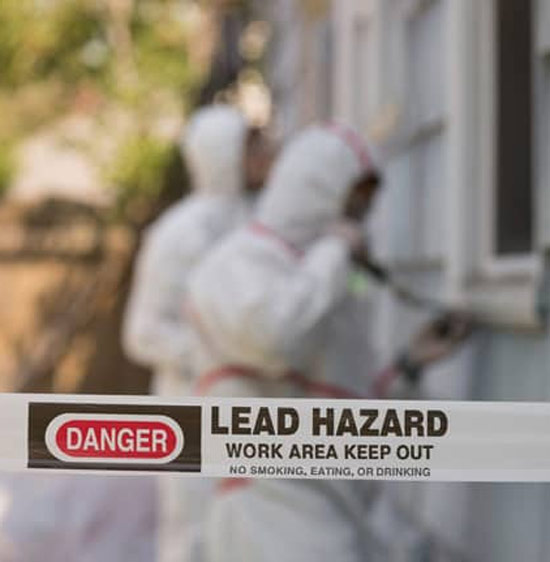DOH & HPD Lead Violation Removal NYC-- Specialist Providers for Conformity
DOH & HPD Lead Violation Removal NYC-- Specialist Providers for Conformity
Blog Article
Comprehensive Guide on Effective Lead Infraction Elimination Strategies
In the world of ecological safety, addressing lead offenses demands a precise and organized strategy. This thorough overview starts by highlighting the essential preliminary steps of determining lead threats with sophisticated assessment and testing techniques. Strategies such as XRF evaluation and dirt clean sampling are indispensable in pinpointing contamination sources. The guide clarifies on the importance of sticking to strict security protocols throughout the removal procedure, consisting of the use of proper PPE and separating impacted areas. The succeeding areas assure to talk about post-removal verification and preventive strategies, making sure long-lasting security and conformity. Discover the elaborate details that make these strategies not simply reliable however vital.
Determining Lead Risks
Recognizing lead threats is a vital initial step in reducing the risks connected with lead exposure. Lead, a toxic steel, can be existing in different environmental mediums, consisting of paint, dirt, water, and dust. It poses extreme wellness dangers, particularly to youngsters and expecting females, leading to neurological damages and developmental hold-ups. Exact identification of prospective lead resources is essential for effective removal.
The first phase in recognizing lead dangers includes comprehending usual lead sources within the constructed atmosphere. Frameworks built before 1978 are particularly at risk due to the widespread use of lead-based paint throughout that period. Furthermore, dirt contamination can take place from deteriorating exterior paint, commercial discharges, or historic use of leaded fuel.
An additional significant resource is lead piping and plumbing fixtures, which can leach lead right into alcohol consumption water. Durable goods such as toys, ceramics, and imported products might also have hazardous lead degrees. Significantly, occupational settings and pastimes involving lead can track pollutants right into homes.
Analysis and Testing
When dealing with lead dangers, efficient analysis and screening are vital. This critical step ensures the identification and quantification of lead visibility, therefore leading subsequent remediation initiatives. First assessment commonly entails an aesthetic evaluation to recognize possible lead resources, such as weakening paint or polluted dirt. This is matched by even more rigorous testing approaches to determine the extent of contamination.

Dust clean tasting is an additional vital technique, specifically in residential settings. By gathering examples from floors, windowsills, and other surfaces, this method supplies insights right into possible exposure risks. Moreover, dirt testing around structure boundaries is vital to find more info here lead contamination that could pose dangers, especially to children.
Safe Elimination Procedures
Upon completing detailed analysis and screening, implementing safe removal treatments is the next important stage in addressing lead dangers. This procedure makes sure that lead-contaminated materials are successfully and securely eradicated, lessening threat to both workers and residents. The very first step involves separating the damaged area making use of plastic sheeting and proper sealing techniques to stop the spread of lead dirt.
Workers need to don appropriate personal safety devices (PPE), consisting of respirators, gloves, and disposable coveralls, to minimize exposure. Using specialized tools and wet methods, such as damp fining sand or using HEPA-filtered vacuums, minimizes the dispersion of lead bits. It is critical to stay clear of completely dry fining sand or unpleasant blasting, as these approaches can generate damaging lead dirt.
Garbage disposal is an additional important component; all contaminated materials need to be safely nabbed and labeled according to EPA and local laws. Additionally, thorough cleansing of the workspace with HEPA vacuums and damp cleaning makes sure the removal of residual lead particles.
Post-Removal Confirmation

Verification of effective lead elimination, understood as post-removal verification, is important to guarantee the safety and security and habitability of the remediated area. This process includes a series of precise analyses site and examinations designed to discover any kind of recurring lead particles that might posture health dangers. The preliminary action generally includes a visual examination to examine the conclusion and top quality of the remediation job. This evaluation ensures that all well-known sources of lead have actually been dealt with which no noticeable signs of contamination continue to be.
Following the aesthetic examination, ecological tasting is performed. This involves collecting dirt, dirt, and in some cases water examples from additional reading the remediated location. Approved laboratories assess these examples to determine lead degrees, ensuring they drop below the safety limits developed by regulative bodies such as the Environmental Protection Company (EPA)
In addition, air quality screening might be done to find air-borne lead bits, especially in instances where considerable lead-based paint removal or remodelling has happened. The outcomes of these tests provide quantitative data confirming that the lead levels are within permitted limitations.
Eventually, post-removal verification works as an essential checkpoint, confirming the efficiency of the lead reduction efforts and safeguarding the wellness of owners and visitors.
Safety Nets and Upkeep

A crucial preventive measure includes making use of lead-safe licensed contractors for any improvement, fixing, or painting tasks. These professionals are learnt practices that reduce lead dirt and debris. Additionally, keeping colored surfaces to prevent damaging or peeling off is vital, as deteriorating paint can release lead particles into the setting.
Educational initiatives targeting residential or commercial property owners and renters relating to the threats of lead and the significance of reporting any kind of potential hazards can better boost preventative efforts. Regular cleansing utilizing HEPA vacuums and damp mopping techniques can dramatically reduce lead dust buildup.
Conclusion
In recap, reliable lead offense removal necessitates a careful approach incorporating thorough analysis, precise testing, and rigid elimination procedures. Recurring assessments and upkeep are crucial to alleviate future lead threats, thus protecting public health and wellness and making sure continual conformity with regulatory needs.
Report this page